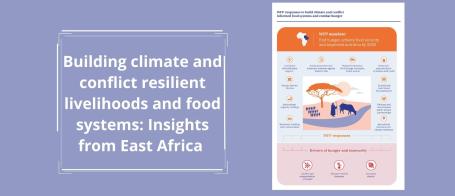Building climate and conflict resilient livelihoods and food systems: Insights from East Africa
Download the full report here.
The Horn of Africa is experiencing a historic drought. Now in its fifth failed rainy season, with a sixth projected to fail in early 2023, 26 million people are expected to enter crisis levels of food insecurity or worse in Somalia, Kenya and Ethiopia. Climate change is exacerbating humanitarian crises and leading to increased mobility, displacing millions each year throughout the Horn of Africa. There is clear evidence of the increased frequency and intensity of climate events ahead, including increases in the number of very hot days expected across East Africa, resulting in the expansion of cropland areas exposed to drought, and increasingly variable rainfall patterns.
Countries experiencing protracted crisis or high risk of famine, are often simultaneously affected by violent conflicts and the impacts of extreme climate change events. International geo-political crises further compound these issues by disrupting supply chains, driving record high food prices, and in 2022, triggering a global crisis adding to the 657 million people projected to be undernourished by 2030.
Food-related instability is often driven by competition for resources related to agriculture or pastoralism, like land availability or distribution, and reform processes that can lead to occurrences of land-grabbing. Further instability related to food systems can result from market failures, such as commodity price fluctuations leading to food riots due to the economic inelasticity of food, such as those witnessed in Kenya and Sudan in 2022, or extreme weather events like heat waves, drought or floods.
For more than 60 years, the World Food Programme (WFP) has been embedded in communities most in need, to bring life saving assistance and support sustainable and resilient livelihoods. In East Africa, WFP works to tackle structural vulnerabilities as well as address shocks from conflict or climate. WFP aims to effectively utilise its comparative programmatic advantage across East Africa, to ensure the continued functionality of sustainable food systems, strengthening resilience to vulnerabilities, shocks and stressors from climate-related disasters, economic crises, and conflicts.
With demands for multilateral funds and foreign aid increasingly stretched thin over a canvas of urgent needs worldwide, it is critical to tackle the dominant disruptors undermining food security and livelihoods, and increasing the risks for conflict. With effective, collaborative action, investments in livelihoods and food systems and climate adaptation can enable a multiplier effect, promoting a transformative climate for peace. This paper outlines recommendations for WFP priorities and its approach.
Share on


